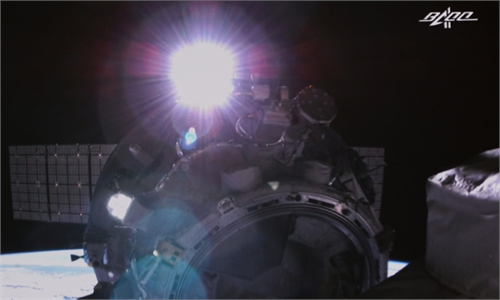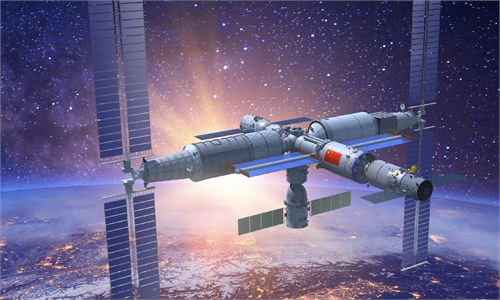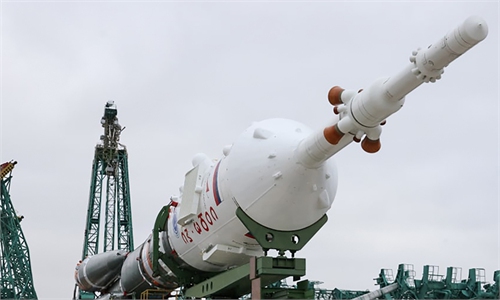Update: Shenzhou-13 separates from Tianhe core module, to bring 3 taikonauts to Earth in 8 hours
CG: China Academy of Spacecraft Technology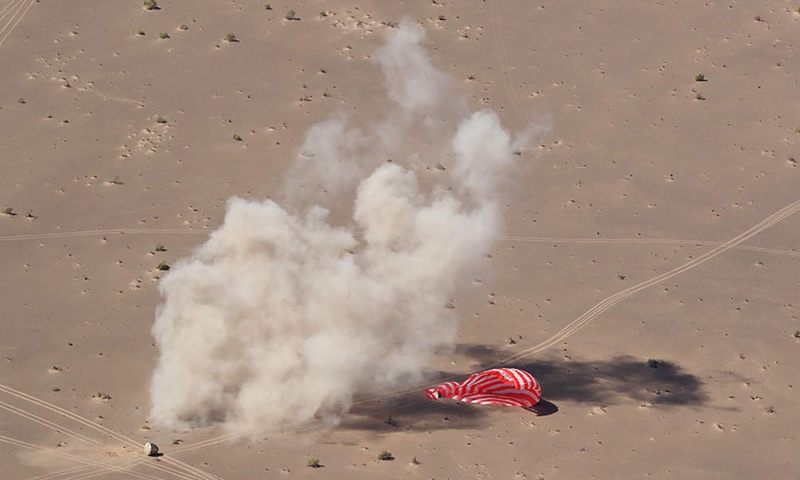
Photo: courtesy of Dongfeng landing site
Carrying taikonauts Zhai Zhigang, Wang Yaping and Ye Guangfu, the Shenzhou-13 manned spacecraft has successfully separated from the Tianhe space station core module by 0:44 am Saturday morning.
The three taikonauts have lived and worked in orbit for 183 days, the longest stay in space by Chinese astronauts in a single mission, the Global Times learned from the China Manned Space Agency (CMSA).
Prior to the separation, the taikonauts had completed various works, such as setting the status of the combination of the core module and cargo spacecraft, sorting and downloading experiment data, and clearing and transferring supplies kept in orbit, with support from staff on the ground, the CMSA said.
The crew is expected to land in the designated Dongfeng landing site in the Gobi Desert, North China's Inner Mongolia Autonomous Region, in some eight hours after the separation.
The search and rescue teams at the Dongfeng landing site said they were already making preparations to receive the Shenzhou-13 crew. They have been carrying out tasks like closely monitoring weather conditions in the area and constructing systems for tracking and monitoring the flight of the spacecraft, read the latest posts by the Dongfeng site on its official WeChat public account.
"Please rest assured, the well-geared and effectively trained ground and air units would be there once the return capsule touches down," the search and rescue teams said in one post.
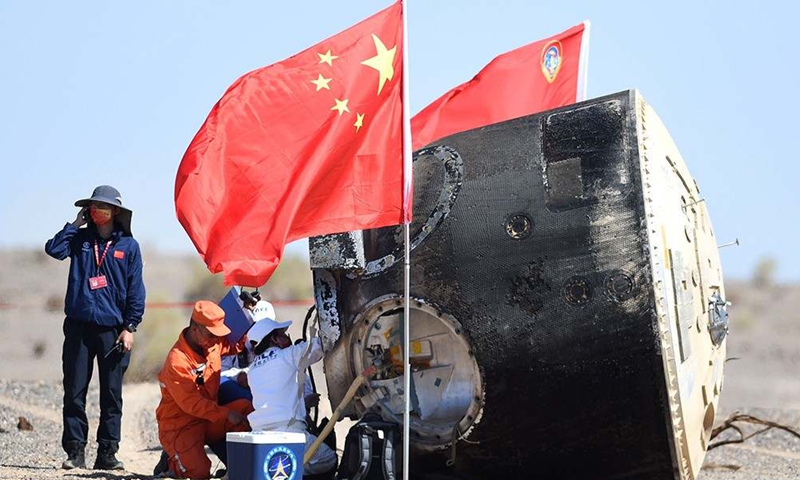
Photo: courtesy of Dongfeng landing site
Eyeing for frontier
Ahead of the Shenzhou-13's return, the Xinhua News Agency reported on Thursday that Chinese President Xi Jinping, during an inspection tour on Tuesday in the Wenchang Space Launch Site located in South China's Hainan Province, demanded efforts to upgrade the spacecraft launch site in the island province with world-leading standards.
Xi, also general secretary of the Communist Party of China Central Committee and chairman of the Central Military Commission, made the remarks at the Wenchang Spacecraft Launch Site. He extended his greetings to all the staff stationed at the site and asked them to shoulder their responsibility and be brave to innovate and make new breakthroughs.
After being briefed on the launch site, Xi inspected the launching tower and other facilities. He spoke highly of a series of key space missions launched from the site, including the launching of the space station core module Tianhe, the Chang'e-5 lunar mission, and the Tianwen-1 Mars probe.
Xi noted that Wenchang is the launch site of China's new-generation high thrust carrier rockets and the bridgehead of the country's deep-space exploration.
The launch site should continue to eye the frontier of global space development and the major strategic needs of China's space industry, and comprehensively improve its modern space launch capabilities, said Xi.
Xi mentioned that Wenchang staff should carefully prepare, coordinate and implement the tasks to ensure the success of missions, and take practical actions to welcome the victory of the Party's 20th National Congress.
As the youngest member of China's spacecraft launch centers, the Wenchang spaceport successfully completed its first launch mission on June 25, 2016, with the maiden flight of China's Long March-7 carrier rocket. On November 3, 2016, the Long March-5 also took its first flight from the launch site.
Staff at the Wenchang spaceport reached by the Global Times said they were greatly encouraged and inspired by the speech from the top leader and vowed to ensure the success of future missions and contribute their wisdom and strength to making China a space power.
Dubbed the "home port for China's space station building missions," Wenchang was the launching site of the Tianhe core module, the Tianzhou-2 and the Tianzhou-3 cargo spacecrafts on April 29, 2021, May 29, 2021, and September 20, 2021, respectively.
On April 11, ahead of Xi's visit, the Tianzhou-4 cargo spacecraft and the Long March-7 Y5 rocket commissioned for the launch mission arrived safely. The next launch is expected to be a third supply run to the Tianhe core module after the return of the crew of the Shenzhou-13.
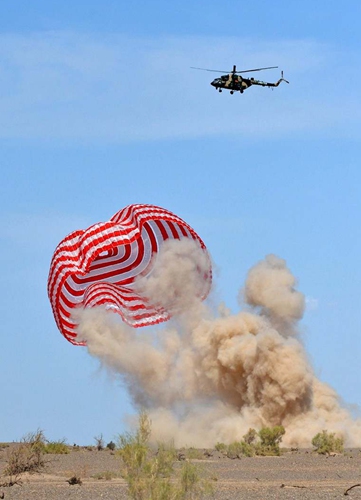
Photo: courtesy of Dongfeng landing site
More than six months
The Shenzhou-13 trio of taikonauts, under the command of Zhai Zhigang, was launched to space with a Long March-2F Y13 rocket from the Jiuquan Satellite Launch Center on October 16, 2021. They were scheduled to break the record of longest in-orbit stay for a single spaceflight mission in the country's space history. They have pulled that off.
The length of stay and their physical and psychological condition in orbit have effectively verified the capability to stay in China's space station in the long term and this is another achievement that suggests China has become a strong space power, Song Zhongping, a space analyst and TV commentator, told the Global Times.
The taikonauts of the Shenzhou-13 have conducted two successful spacewalks with Wang Yaping becoming the first Chinese woman in history to perform this maneuver.
The crew also delivered two Tiangong Classroom science lectures for students on Earth, connecting with youth from Beijing, Hong Kong, Macao, and Xinjiang and Xizang autonomous regions.
They have also played a significant part in many historic moments in China in the past six months, sending their greetings and congratulations during the Chinese New Year and joining the spectators of the Beijing 2022 Winter Olympic Games from space.
The crew completed more than 20 scientific experiments in orbit, including those focused on new technologies to monitor the taikonauts' wellbeing in space, innovation, and new discoveries as well as data collection.
These studies will give us a better understanding of how the weightless environment impacts human beings, and also provide a great experiment model to contribute to the study of general public health issues such as aging and heart diseases, said Li Yinghui, deputy chief designer of the country's taikonaut training system.
Experts noted that six months is an international standard for the duration of stays. However, China is not competing and has never sought to compete with other space powers. As long as the station is properly attended to and the goal of the mission is met, the duration does not matter, and taikonauts can take shifts to allow more people in the candidate pool to have a chance, ensuring the health and safety of taikonauts in orbit, Song said.
Pang Zhihao, a senior space expert, said the average length of orbital stay for the astronauts of the International Space Station is also about six months and China could reach this level as soon as in the second mission to the country's own space station, which is a great achievement.
Analysts said the success of the first six-month mission has laid the foundation for future manned missions which would allow more room for imagination that amateur taikonauts, such as flight engineers, space scientists and even foreign astronauts would have no problem living and working in China's space station once it is fully completed.
Russian cosmonaut Anton Shkaplerov recently said in an interview that China's space program is "good and fast," and that China "knows how to do things" when it comes to manned spaceflights. He and his colleagues are willing to participate in China's space programs if China allows it, be they near-Earth orbit missions or deep-space explorations to the Moon and Mars.
Shao Limin, deputy technology manager of manned spaceship systems, told the Global Times that the Shenzhou-13 spacecraft will fly five orbits before returning to Earth, which is 13 orbits less than the Shenzhou-12 mission. It will take about seven to eight hours.
The fast-return technique requires little adjustment to the hardware and software of the spacecraft, but mainly making the flight control more compact, Shao said.
"We have prepared a day for the return of the taikonauts. Although such duration meets the standards, a day of flight in the tight cabin is uncomfortable for them, especially after they have spent six months in space. We want our taikonauts to return in a shorter time. That is why we decided to adopt the fast return technique," Shao noted.
Bai Linhou, deputy chief designer of China's space station, said in an interview that two experimental modules are expected to be launched in the second half of this year. The verification and assembly work of the modules is progressing smoothly.
Both lab modules have a length of over 17 meters and a diameter of over 4 meters.
The Wentian module is positioned to carry out space science experiments inside and outside the cabin. It has an airlock through which taikonauts can exit, and a small robotic arm which can be used alone or combined with the large mechanical arm of the space station.
It can also serve as a backup to the core cabin, Bo said. If malfunction occurs in the core cabin, the Wentian module can replace it immediately, improving the reliability of the entire station's operation.
The other lab module, the Mengtian, has a cargo airlock. The small robotic arm on the lab module can also grab payload via the airlock and install them onto the experiment platform outside the cabin.
